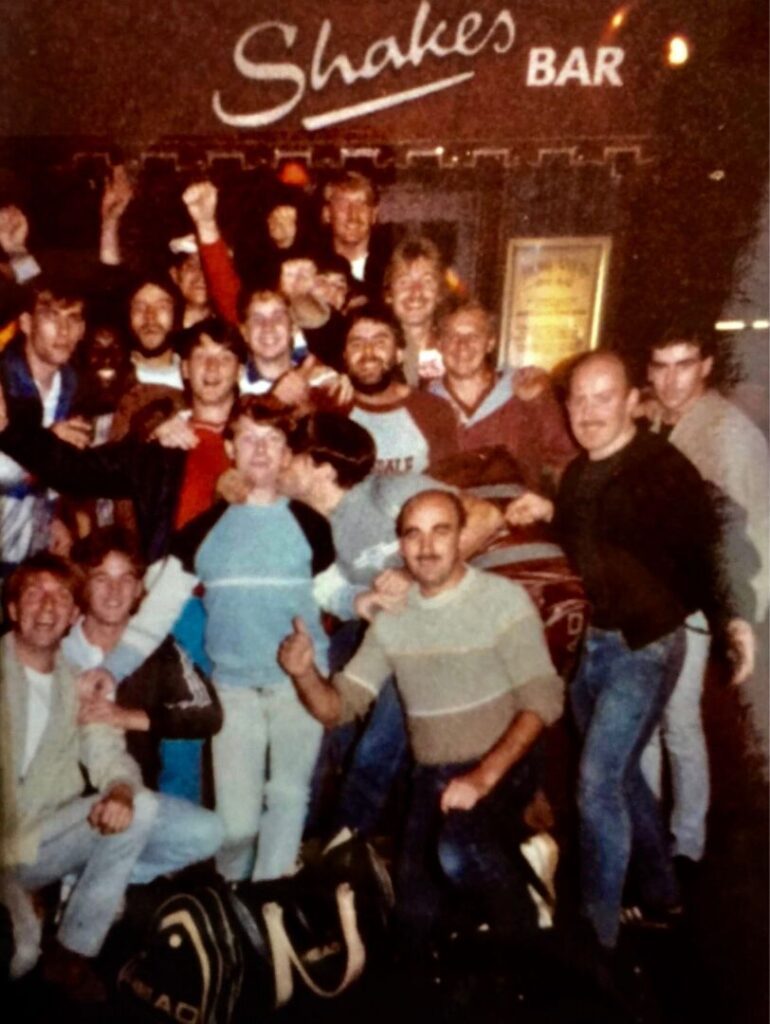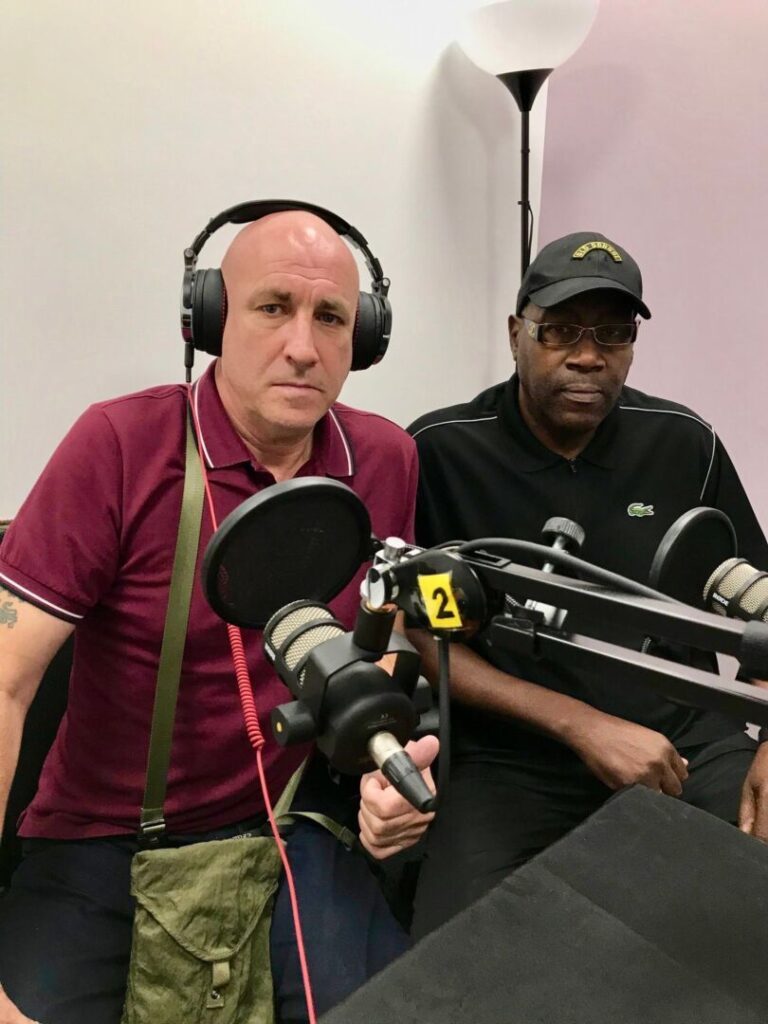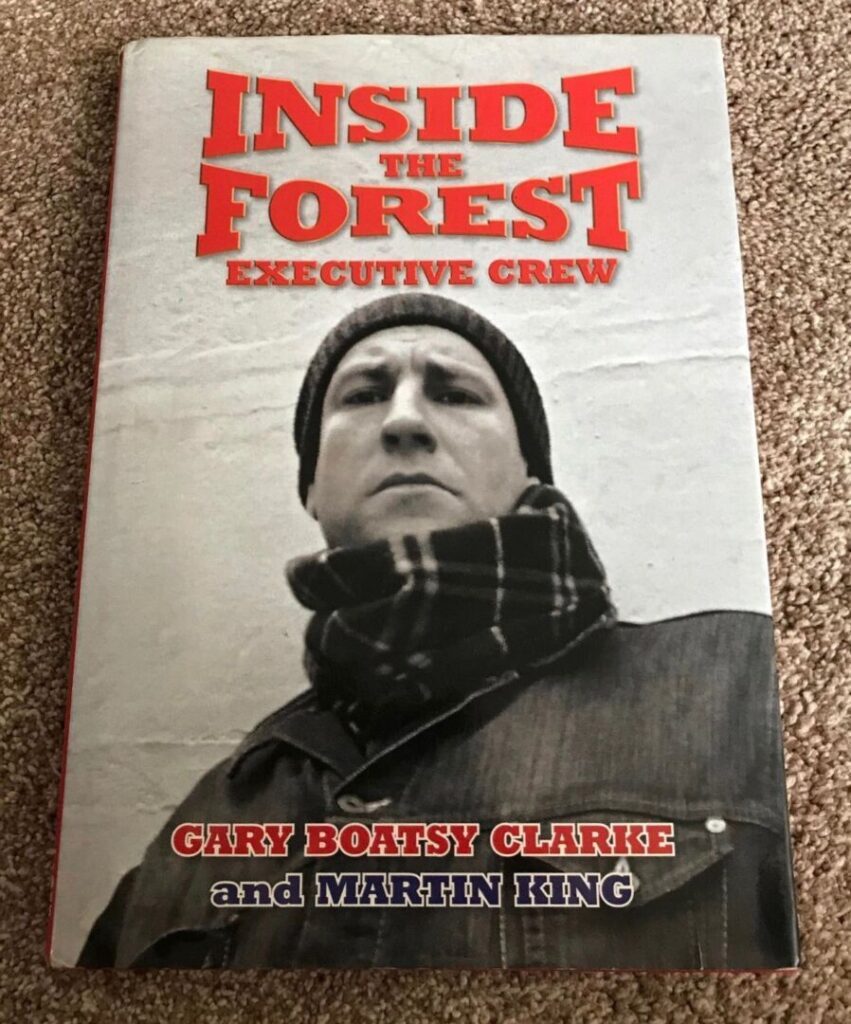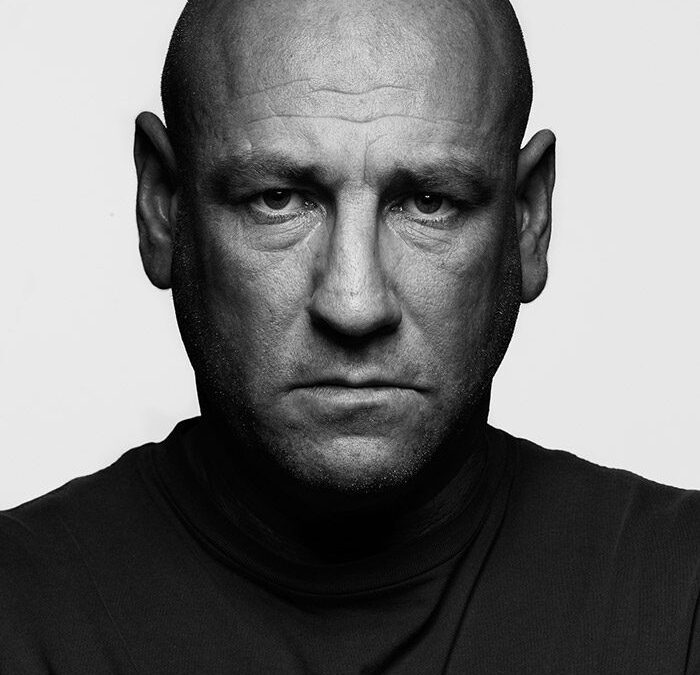„Wenn man einmal ein Buch geschrieben hat, gibt es kein Zurück mehr. Das Spiel ist aus.“
Gary „Boatsy“ Clarke war einst Mitglied der berüchtigten Forest Executive Crew von Nottingham Forest und die älteren Leser, werden ihn vermutlich durch die Dokuserie The Real Football Factories von Danny Dyer her kennen. Er war auch die erste Person in Nottinghamshire, gegen die ein zivilrechtliches Verbot verhängt wurde, und hat seit der Einführung insgesamt fünf Banning Orders erhalten. Boatsy ist Autor des Buches „Inside the Forest Executive Crew“, das er gemeinsam mit Martin King im September 2005 herausgegeben hat.
Da wir hier recht wenig über Forest, die F.E.C. und die Stadt Nottingham wissen, ist es uns eine besonders große Freude den guten Mann für ein Interview mit uns gewonnen zu haben. Wir unterhalten uns über seine Heimatstadt, Forest, seinen Werdegang beim Fußball, die F.E.C. und natürlich auch über die Casual Culture und sein Buch.
Holt euch schnell ein Bier oder Apfelwein aus dem Kühlschrank und jetzt viel Spaß unserem Gespräch mit Boatsy!
For our international follower: For the interview in English please scroll down.

Gude Boatsy, es ist uns eine große Ehre und Freude, dich bei uns zu haben. Wie geht es dir?
Gut, danke. Ich hatte sehr viel zu tun, aber es ist sehr schön mit euch zu plaudern.
Könntest du dich bitte unseren Lesern vorstellen, falls sie dich noch nicht kennen sollten?
Ich bin Gary Clarke, auch bekannt als Boatsy, ein großer Nottingham-Forest-Fan seit fast fünfzig Jahren.
Ich bin in Nottingham aufgewachsen, geboren in Sneinton im Osten der Stadt, wo meine Mutter und ihre Eltern herkommen. Ihr Vater ist ein großer Fan von Notts County, dem ältesten – oder sollte ich sagen: ehemals ältesten – Ligaverein der Welt. Wenn ich zu Hause war, hat er mich immer mitgenommen, um sie spielen zu sehen.
Mein Vater hingegen kommt aus dem Süden, aus Cambridge, und meine Großmutter ist irischer Abstammung. An den Wochenenden bin ich immer dortgeblieben und habe mir Cambridge United angesehen, und in der Schule hatte ich auch eine Schwäche für Leeds United (mehr Vereine als Jack Nicholas).
Als ich fünf Jahre alt war, zogen wir in einen wohlhabenderen Teil der Stadt, um ein besseres Leben zu führen.
Wenn ich richtig informiert bin, gibt es in der Stadt mit Ye Olde Trip To Jerusalem, den ältesten Pub der Welt. Wie würdest du Nottingham den Leuten beschreiben, die es noch nicht besucht haben?
Nottingham ist eine großartige Stadt zum Leben, mit viel Geschichte und einem tollen Nachtleben. Ich schätze mich also glücklich, mein Leben hier verbracht zu haben – obwohl Cambridge auch ziemlich cool ist.
Wie ich schon sagte, ist die Stadt sehr geschichtsträchtig, mit der Legende von Robin Hood, dem Schloss und der Stadt der Höhlen, die unter der Stadt verläuft und in der vor Jahrhunderten Schmuggler ihre Waren verkauften. Außerdem haben wir hier den ältesten Pub Englands – Ye Olde Trip to Jerusalem, der ebenfalls ein Höhlennetz unter sich hat und in dem es spukt! (City of Caves ist eine Besucherattraktion in Nottingham, die auf einem Netzwerk von Höhlen aus Sandstein basiert. Hier sind heute auch viele Bars zu finden. Anm. d. Red.)
Das klingt auf alle Fälle sehr einladend. Gibt es vielleicht einen bestimmten Charakterzug oder eine bestimmte Mentalität der Menschen in Nottingham oder sogar der Forest-Fans?
Ich würde sagen, dass die Menschen in Nottingham sehr loyal sind. Und das kann man auch von den Forest-Fans sagen, die in den letzten 23 Jahren, in denen sie ohne großen Erfolg in den unteren Ligen gekämpft haben, mit ihrem Team durch dick und dünn gegangen sind.

Lass uns jetzt auf deine Fußball-Vita zu sprechen kommen. Wie bist du mit dem schönen Spiel in Berührung gekommen?
Ich war schon als kleiner Junge fußballverrückt, genau wie mein Sohn jetzt. Ich war schon immer ein Forest-Fan, aber wie ich schon sagte, hatte ich als Kind eine kleine Schwäche für Leeds und Cambridge United.
Forest war in den späten siebziger und frühen achtziger Jahren sehr erfolgreich und gehörte zu den großen Namen im britischen und europäischen Fußball. Premier-League-Meister 1978, Europapokalsieger 1979 und 1980, Football-League-Pokalsieger 1978, 1979, 1989 und 1990, europäischer Supercup 1979. Wie hast du diese großartige Zeit mit deiner Mannschaft erlebt?
Als ich ’74 zum ersten Mal ins Stadion ging, war Forest eine kämpfende Mannschaft in der 2. Liga, kurz bevor der großartige Brian Clough das Ruder übernahm. Viele Mitschüler mochten damals Liverpool oder Leeds. Ich hatte das Glück, in dem Jahr, in dem wir die Liga gewannen, eine Dauerkarte zu ergattern, und wie du schon sagtest, der Rest ist Geschichte. Wir gewannen buchstäblich alles, was der Fußball zu bieten hatte und eroberten zweimal Europa. Ich war jedes Jahr in Wembley. Es war wie ein Traum, von dem wir dachten, er würde nie enden.

Wie sah deine „Fankarriere“ von der Kurve zur Firm aus? Wie bist du mit den Top Boys in Kontakt gekommen?
Ich bin eher zufällig in die Firma geraten, als ich mir ein Spiel zwischen Leeds und Notts Country ansah und ein Fan von Forest auf uns losging. Vor dem Eintreffen der Polizei hatte ich mich jedoch zur Wehr gesetzt. Und Woche für Woche sahen mich die Jungs in Nottingham beim Ausgehen, was sie nicht glauben konnten, weil sie dachten, ich sei ein Junge aus Leeds. Von da an wurden wir Freunde und ich begann, mit ihnen herumzuhängen. Es war aufregend mit ihnen wegzugehen usw., die Kleidung und die Musik und die Kultur. Wir waren die Forest Casuals und nannten uns später nach einem Stand, in dem wir saßen: The Forest Executive Crew (F.E.C.) und wir begannen, uns einen ziemlich furchterregenden Ruf zu verschaffen.
Vor uns, in den 70er Jahren, waren es die Forest Green Jackets (Flying Jackets) Mad Squad, die in den 70er Jahren ebenfalls einen sehr guten Ruf im ganzen Land hatten.
Welchen Stand hattest du in der F.E.C.? Warst du die Kontaktperson für gesellige Zusammentreffen?
Ich habe mir als junger Mann schnell einen guten Ruf erarbeitet und bin in den 80er und 90er Jahren aufgestiegen und habe angefangen, für unsere Jungs Reisen und Busse zu organisieren. Du weißt ja, nur um Spaß zu haben, landauf, landab.
Welche der anderen Firms habt ihr für ihre Aktionen respektiert?
In den 80er Jahren waren das die meisten Londoner Vereine wie West Ham, Arsenal usw. sowie United im Norden, Middlesborough und Pompey. Um ehrlich zu sein, hatten zu der Zeit die meisten Mannschaften einen ordentlichen Mob und es gab so einige Gelegenheiten.

Was waren die denkwürdigsten Schlachten, an denen du beteiligst warst?
Ich hatte einige epische Schlachten mit United, den Zulus (Brum), die ich für die besten aus den Midlands halte. Um ehrlich zu sein, war auch QPR immer sehr lebhaft. Natürlich waren auch unsere Lokalrivalen Derby County und Leicester immer gut drauf.
Kommen wir zur Mode oder besser gesagt zur Casual Culture. Wie wichtig war es für dich die richtigen Marken zu tragen?
Die Kleidung war mir unheimlich wichtig und das ist ein weiterer Grund, der mich zur Terrace Culture hingezogen hat, denn das hat mich unheimlich fasziniert. Man hat studiert, was bestimmte Fans trugen, da es im Norden anders war als im Süden und in den Midlands.
Man hat immer versucht, am schicksten auszusehen und den Rivalen eins auszuwischen, nur damit das geliebte Kleidungsstück in einer Woche vom Rücken gerissen wird. Ich liebte den alten, verblichenen Jeans-Look mit den Pringle-Pullovern, dem Wedge Haarschnitt und weißen Trainers. Einfach klasse.
Ich denke, dass die F.E.C. immer gut gekleidet war, immer mit den neuesten Klamotten. Aber zu der Zeit war wohl Leicester proper ausgestattet und Arsenal vermutlich am besten gekleidet war. Unser Rivale Derby konnte in dieser Hinsicht nicht mithalten.

Welche Marken trägst du heute auch noch gerne?
Heutzutage mag ich Belstaff, Paul Smith, C.P. Company und je älter ich werde, desto mehr wird es ruhiger.
Was denkst du über den Hooliganismus von heute? Ist er zu einer eigenen „Sportart“ außerhalb des Oktagons geworden oder siehst du immer noch die Verbindung zur altmodischen Fußballgewalt?
Um ehrlich zu sein, kann ich damit heutzutage nichts anfangen. Ich mag heute keine Gewalt mehr und gehe auch nicht in ihre Nähe.
Die Osteuropäer und Russen haben es auf eine andere Ebene gebracht, wo sie sich gegenseitig einstampfen. Deutschland und Polen haben heutzutage schmackhafte Fans, aber ich bin immer noch in den guten alten 80er Jahren und lasse es dort. Das wirst du nie wieder sehen, es war eine britische Subkultur.
Eine weitere Besonderheit Nottinghams ist, dass die Stadt zwei Profivereine beherbergt. Wer die Luftbilder von Nottingham kennt, weiß, dass nur der Fluss Trent die beiden Stadien von Forest und Notts County trennt. Möchtest du etwas über die mehr als hundert Jahre alte Rivalität erzählen?
Notts County war in den 40er und 50er Jahren der größere Verein und hat immer noch eine große Fangemeinde. Um ehrlich zu sein hatten Forest-Fans nie ein großes Problem mit ihnen, obwohl sie uns nicht mögen. Es ist wie eine Eifersucht, die sie über die Jahre entwickelt haben. Einen Mob konnte Notts County auch erst in den letzten Jahren auf die Beine stellen.
In den letzten Jahren gab es ein paar Schlachten, aber das war nach meiner Zeit. Ein weiterer Verein, der vermutlich zwanzig Jahre zu spät dran ist.
Wie kann man sich dann die Beziehung unter der Woche vorstellen, wenn die anderen plötzlich Kollegen im gleichen Unternehmen oder in der gleichen Schule sind?
Ich denke, in den Betrieben und Schulen blieben sie unter sich anstatt irgendetwas zu versuchen, denn in den letzten fünfzig-sechzig Jahren waren wir für sie viel zu groß.

Wenn ich richtig informiert bin, verbindet dich eine persönliche Freundschaft mit den Jungs vom 1. FC Köln und du warst auch selbst einige Mal am Rhein zu Gast. Wie sind die Kontakte zustande gekommen und unterstützt ihr euch auch heute noch gegenseitig?
Ja, wir haben eine ganz besondere Beziehung zum 1. FC Köln, die nun schon fast zwanzig Jahre zurückreicht. Ich muss zugeben, dass ich dachte, es hätte so oder so ausgehen können, aber sie waren großartig zu uns und es sind lebenslange Freundschaften entstanden.
Unser Traum wäre es, ein besonderes Freundschaftsspiel zu haben. Außerdem haben wir eines der besten Champions-League-Halbfinalspiele der Geschichte gegeneinander gespielt. Ich gehe jetzt seit zwanzig Jahren zu Heim- und Auswärtsspielen des FC und habe unzählige Spiele besucht. Das Gleiche gilt für die Jungs aus Köln und ihren Besuchen in Nottingham.
Kommen wir zu deinem Buch, Boatsy, das 2005 veröffentlicht wurde. Was hat dich persönlich angetrieben „Inside the Forest Executive Crew“ zu schreiben?
Ich habe schon vor meinem Buch Angebote bekommen, Bücher und Artikel zu schreiben, aber ich war noch aktiv. Eines Tages wurde ich verhaftet und kam 2004 ins Gefängnis. Ich saß in meiner Zelle und dachte: Es ist Zeit, mich zurückzuziehen und mit dem Schreiben zu beginnen. Der beste Weg war also, es schriftlich festzuhalten, denn wenn man einmal ein Buch geschrieben hat, gibt es kein Zurück mehr. Das Spiel ist aus.

Wie lange hast du an dem Buch gearbeitet?
Ich habe es zusammen mit Martin King geschrieben, einem ziemlich bekannten Autor (u.a. Hoolifan: 30 Years of Hurt, Anm. d. Red.) über die britische Subkultur. Es dauerte etwa sechs Monate, in denen wir die meisten Wochenenden zusammen an der Südküste und in Nottingham verbrachten. Leider ist Martin kürzlich an einer Krankheit verstorben.
Das tut mir sehr leid zu hören. Wie haben deine Familie, alte Weggefährten, die Fußballszene und die Medien reagiert, nachdem dein Buch beworben und veröffentlicht wurde?
Es gibt immer ein paar Leute, denen es nicht gefällt, wenn man seine Geschichte veröffentlicht. Aber es gab niemanden, der nicht im Buch vorkommen wollte.
Um ehrlich zu sein waren meine Eltern darüber verärgert, aber die Medien waren immer fair. Da es mehr eine Lebensgeschichte ist, in der es um England und Forest geht und viele Leute es interessant und amüsant finden.
Boatsy, du warst auch an der Fotoserie GBH von Simon Harsent beteiligt. Herausragende Porträts von Top Boys von den berüchtigtsten britischen Banden. Wie kam es zu dieser Idee?
Simon Horsant, einer der weltbesten Fotografen, kontaktierte Cass Pennant mit dieser Idee. Er hatte ein Projekt über das „Beautful Game“ gemacht und wollte die Bilder von der düsteren Seite des Spiels einfangen. Es ist wirklich gut geworden (auch wenn ich mir nicht sicher bin, ob das Foto ohne Oberteil denn sein musste), und die Ausstellung in Sydney war direkt ausverkauft. Ich stehe auch immer noch mit Simon in Kontakt.

Wenn du zurückblickst – gäbe es irgendetwas, für das du dein Leben lieber verschwendet hättest, wenn es nicht der Fußball gewesen wäre?
Ich bereue nichts von dem, was ich in meinem Leben getan habe. Weder Fußball noch sonst etwas, denn dann wäre ich nicht der Mann, der ich heute bin. Durch den Fußball habe ich Freunde auf der ganzen Welt, Freunde fürs Leben, die gute Menschen sind.
Was machst du eigentlich heute, Gary? Wenn ich richtig informiert bin, bist du beim Siebtligisten Carlton Town FC aktiv.
Heutzutage bin ich ein Familienvater, der seinen 12-jährigen Sohn jede Woche zum Fußball mitnimmt, und ein großer Kricket-Fan, der die englische Nationalmannschaft verfolgt. Ich wurde ich in den Vorstand eines semiprofessionellen Fußball-Amateuervereins gewählt und zwar als kaufmännischer und Marketing-Manager – was mir sehr viel Spaß macht, obwohl es ein sehr arbeitsreicher Teilzeitjob ist. Es ist großartig, dem Fußball etwas zurückzugeben, anstatt ihn auszunehmen. Ich habe das Gefühl, dem Fußball etwas zu schulden.
Vielen Dank für deine Zeit und die Gelegenheit zu diesem Interview mit dir, Boatsy. Ich wünsche dir alles Gute für deine Zukunft. Die letzten Worte in diesem Interview gehören dir.
Es ist großartig, dem Fußball etwas zurückzugeben, anstatt ihn auszuschalten, ich habe das Gefühl, dass ich dem Fußball etwas schulde. Ich möchte mich bei dir für die Einladung bedanken, denn ich bin auch ein großer Fan des deutschen Fußballs und eurer Nationalmannschaft. Alles Gute für die Zukunft. Gary Boatsy
—The Interview in English starts here—
„As once you do a book there’s no going back. Game over.“
Gary „Boatsy“ Clarke was once a member of Nottingham Forest’s infamous Forest Executive Crew and older readers, will probably know him from Danny Dyer’s documentary series The Real Football Factories. He was also the first person in Nottinghamshire to be civilly banned and has received five Banning Orders since its introduction. Boatsy is the author of Inside the Forest Executive Crew, a book he co-edited with Martin King in September 2005.
Since we here know quite little about Forest, the F.E.C. and the city of Nottingham, it is a particular pleasure to have secured the good man for an interview with us. We talked with him about his hometown, Forest, his career in football and at the stands, the F.E.C. and of course about casual culture and his book.
Get yourselves a beer or cider from the fridge and now enjoy our conversation with Boatsy!

Hi Boatsy, it´s a big honour and pleasure to having you with us. How are you, mate?
Good thanks, been so busy though, nice to chat to you guys.
Could you please introduce yourself to our readers in the case they should don´t know you.
I’m Gary Clarke, AKA Boatsy, a big Nottingham Forest supporter of nearly 50 years. I grew up in Nottingham, born in Sneinton in the east side of the city, where my mother is from and her parents, her dad being a big Notts County fan, the oldest – or should I say formerly oldest league club in the world. He used to take me to watch them when at home. My dad on the other hand, is from the South, Cambridge, my grandmother that side being Irish. I used to stay there at weekends and watch Cambridge United, I also had a soft spot at school for Leeds United (more clubs than Jack Nicholas). At the age of five, we moved to a more affluent part of the city for a better life.
If I’m informed correctly, the city has Ye Olde Trip To Jerusalem, the oldest pub in the world. How would you describe Nottingham to people who have not yet visited?
Nottingham is a great city to live in, with a lot of history and great nightlife, so I guess I’m pretty lucky to have spent my life here – although Cambridge is pretty cool too. Like I say, it’s steep in history with the legend of Robin Hood, the castle, and it’s called the City of Caves as a network runs under the city, where centuries ago smugglers used to the trade their goods. Also, we have the oldest pub in England – Ye Olde Trip to Jerusalem, which also has a cave network underneath and is haunted!
That sounds very inviting in any case. Is there perhaps a certain trait or mentality of the people in Nottingham or even of Forest Fans?
I would say that the people of Nottingham are very loyal and that could also be said of Forest fans, who have stuck with their team through thick and thin over the last 23 years of hurt in the lower leagues without much success.

Let’s talk about your football vita now. How did you get in touch with the beautiful game?
I’ve been mad on football since I can remember as a small boy, just as my lad is now. I’ve always been Forest, but like I say as a kid, had a soft spot for Leeds & Cambridge United.
Forest were hugely successful in the late seventies and early eighties and were one of the big names in British and European football. Premier League Champion 1978, European Cup Winner 1979 and 1980, Football League Cup Winner 1978, 1979, 1989 and 1990, European Super Cup 1979. How did you experience this great time with your team?
When I first started going in ’74, Forest were a struggling 2nd Division side, just before the great man Brian Clough took over, so lots of kids at the time liked Liverpool or Leeds like myself. But I went to watch Forest, I was lucky enough to acquire a season ticket the year we won the league and like you say, the rest is history with us winning literally everything the game had to offer, conquering Europe twice. I went to Wembley every year. It was like a dream we thought would never end.

What was your „supporter journey“ like from the stand to the Firm? How did you get in touch with the top boys?
I fell into the firm by accident really, as I was watching Leeds at Notts Country and a fan of Forest picked on us, but I stood my ground before the police came. And week after week they spotted me in Nottingham on a night out which they couldn’t believe, as they thought I was a Leeds lad. And from then on, we became friends and I started hanging around with them. It was exciting with them going away etc, the clothes and music and the culture. We were and become the Forest casuals and named ourselves after a stand we sat in, The Forest Executive Crew (F.E.C) and began to get ourselves a pretty fearsome reputation. Before us, in the 70’s, it was the Forest Green Jackets (Flying Jackets) Mad Squad, who also had a very good rep around the country in the 70’s.
What status did you have in the Firm? Were you the contact person for sociable groups?
I soon started to earn a good rep as a young lad and progressed through the ranks throughout the 80’s and 90’s and started to organise our lads with travel and coaches purely for the fun up and down the country, it was a – should I say – entertaining time.
Who of the other firms did you respect most for their actions?
In the 80’s, I respected most London firms West Ham, Arsenal etc and United in the North, Middlesborough, Pompey. Most teams had tidy mobs to be honest and you would get it at most places.

What were the most memorable battles you were involved in?
I’ve had some epic battles with United, the Zulus (Brum) who I rate as the best from the Midlands. QPR was always lively to be honest. Obviously our local rivals Derby & Leicester was always good.
Let´s speak about the casual culture. How important was it for you to wear designer clothes?
The clothes were very important to me, and that’s another reason that drew me towards the terrace culture, as I was fascinated by it. You would study what certain fans wore, as it was different in the North to the South and the Midlands. You would always try to look the smartest, and get one up on your rivals, only for it to get ripped of your back one week. I loved the old faded jeans look with the diamond Pringle jumpers, wedge haircut and white trainers, class.
Followed by the question, what was your favourite matchday look?
I would like to think the F.E.C were always well turned out, always up there with the latest gear, although I thought Leicester were tidy and Arsenal the best dressed firm, didn’t rate Derby in that department (way behind).

Are there some casual brands you (still) like most?
These days, I like the Belstaff, Paul Smith, C.P. Company, a lot more toned down the older I’m getting.
What do you think about hooliganism today? Has it become more like some sport of its own (outside the octagon) or do you still see the link to the old fashioned footie violence?
To be honest, it doesn’t do anything for me these days, I don’t like violence and don’t go anywhere near it. The Eastern Europeans and Russian’s have taken it to another level, where they kill each other. Germany and Poland have tasty fans these days, but for me I’m still in the good old 80’s, leave it there. You’ll never see that again, a British subculture.
Another special feature of Nottingham is that the city is home to two professional clubs. Anyone who knows the aerial photos of Nottingham knows that only the River Trent separates the two stadiums of Forest and Notts County. Would you like to tell us something about the more than one hundred year old rivalry?
Notts County were the bigger club in the 40’s & 50’s and still has a good fan base, us Forest fans have never really disliked them to be honest, although they don’t like us. It’s like a jealously they have and only in recent years have they developed a mob.
There’s been a few battles in recent years but after my time. Another club that’s 20 years too late.
Following on from that, how can we imagine the relationship during the week when the others are suddenly colleagues in the same company or at the same school?
I think in the work places and schools they keep themselves to themselves, as in the last 50/60 years we have been far too big for them.

If I am informed correctly, you have a personal friendship with the boys from 1. FC Köln and you have been there yourselves. How did the contacts come about and do you still support each other today?
Yes we have had a very special relationship with FC Koln which now spans back nearly 20 years. It began with a few of us going over to watch a game and we were taken to their pub, I must admit I thought it could have gone either way but they were brilliant with us and lifelong friendships have been formed, even where the clubs are friends too, our dream would be to have a special friendly. Also, we played one of the best ever Champion league semi-finals in history. I’ve been going to FC Koln games now for 20 years home & away, I’ve lost count, same goes for FC boys and ours.
Let´s speak about your book, mate. It was first published in 2005. For the people who don´t know the book please describe in your own words what drove you to write “Inside the Forest Executive Crew“?
I’ve been offered to write books and articles before my eventual book, but I was still active. But then I got arrested and sent to jail in 2004, I sat in my cell I thought, it’s time to retire and move on. So the best way was to put it in writing, as once you do a book there’s no going back, game over.

How long did you work on it?
I wrote it with Martin King, a pretty well known author on British subculture in the UK, it took around 6 months of spending most weekends together down on the South Coast & Nottingham. Sadly, Martin passed away recently due to illness.
I´m really sorry to hear this. How did react your family, old companions, the football scene and the media after your book was promoted and published?
There’s always a few people that don’t like you putting your story in print, but no one was in the book that didn’t want to be. My parents were angry about it to be honest, but the media have always been fair as it’s more of a life story of following England and Forest, and a lot of people find it interesting and funny.
Boatsy, you were also involved in the photo series GBH by Simon Harsent. Outstanding portraits of top boys from the most notorious British firms. How did this idea come about?
The photos GBH by Simon Horsant who’s a top world photographer, he contacted Cass Pennant with the idea. As he had done a project on ‘the beautiful game’ and wanted to catch the images, of the more sinister side of it. It turned out really good (although not sure about me with my top off), it sold out at it’s exhibition in Sydney. I still keep in touch with Simon too.

Looking back – if it hadn’t been for football, is there anything you’d rather had your life wasted on?
I don’t regret anything I’ve done in my life, football, whatever, as I wouldn’t be the man I am today. I have friends all over the world because of football, lifelong friends who are good people.
What are you doing today, Gary? If I am informed correctly, you are active with the seventh division club Carlton Town FC. What role have you taken on at the club?
These days, I’m a family man who takes his 12 year old to football every week, and a big cricket fan who follows the England team. I’ve been like you say, elected on the board of a non-league, semi-professional football club, as commercial and marketing manager – which I’m loving, although it’s a very busy part time job. It’s great to give something back to football instead of taking it out, I feel like I owe football something
Many thanks for your time and the opportuntiy to this interview with you, Gary. I wish you all the best for your future. The last words of this interview are yours.
It’s great to give something back to football instead of taking it out, I feel like I owe football something. I’d like to thank you for inviting me to do this, as I’m also a big fan of German football, and your national team. All the best for the future. Gary Boatsy


